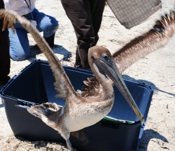In the wake of Saturday's failure of a "top kill" procedure to stem the gusher of oil in the Gulf of Mexico, British Petroleum will again attempt to cap the flow. This newest procedure, however, involves cutting the leaking pipe from the blowout preventer, increasing the flow for three or four days until a new containment dome can be put into place to allow the company to siphon off the oil, reports The Miami Herald.
The company, however, has already attempted twice to lower domes on top of the leak, and has been unsuccessful in either attempt. BP has not stated how much more oil will be put into the Gulf during the operation.
"All of these operations, including the cutting of the riser, are complex, involve risks and uncertainties, and have to be carried out by ROVs at 5,000 feet under water. Systems such as the LMRP containment cap have never before been deployed at these depths and conditions, and their efficiency and ability to contain the oil and gas cannot be assured. It is currently anticipated that attachment of the LMRP cap will be attempted later this week; however, operational delays could impact anticipated timeframes," BP stated this morning.
Depending on who is doing the estimating, the current amount of oil rushing into the Gulf is between 504,000 gallons and 4.2 million gallons a day. That puts the total oil from the spill between 20 million and 175.5 million gallons according to an online counter at PBS. More than 126 miles of Louisiana coastline has been affected, with most recent forecasts predicting landfall in Mississippi and Alabama later this week.


